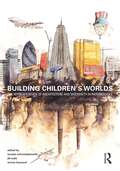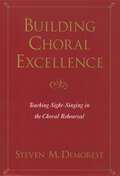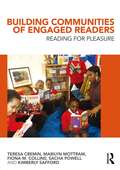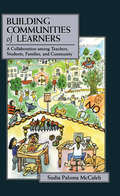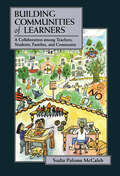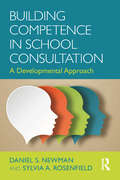- Table View
- List View
Building Brilliant Connections Between Families and Schools: Better Engagement with Education Communities
by Jennifer RossThis timely and accessible resource explores the complex relationship between school practice and parental engagement and is a result of rich collaboration between educational professionals, policy makers and innovators in bridging the often-challenging gap between school and home.Considering the way schools liaise with parents and the wider school community, the authors provide ideas for innovative ways to develop relationships. Based on unique findings from highly-effective schools who are committed to bridging this gap, this book highlights the importance of using effective partnerships and practitioners understanding the importance of a transparent two-way approach. Case studies and first-hand experiences from educational professionals, parents and members of parent councils will reveal how school policy reform can positively impact school engagement and outcomes for children. This book covers a broad range of areas such as: Parent councils. Strengthening links between schools and educational settings. SEND – Comparisons between mainstream and SEN schools. The role of voluntary action groups within education. Fundraising and the impact of voluntary action within education. Building positive relationships that enhance teacher wellbeing. Building Brilliant Connections Between Families and Schools is a key resource for all individuals interested in education, including educational professionals involved in academic outcome, community engagement and parental partnerships within schools. It will aid as a guide to developing approaches for teachers and school leaders, providing opportunities for growth within their own educational setting.
Building Brilliant Vocabulary: 60 Lessons to Close the Word Gap in KS3 (PDF)
by Katie AshfordBuild brilliant vocabulary to help close the word gap in KS3 English with ready-made vocabulary activities for 60 high leverage Tier 2 words and teaching guidance informed by evidence and research. 60 ready-made lessons and student worksheets to share with your department to build confidence in teaching vocabulary in KS3 to improve students’ conceptual knowledge and prepare for GCSE 9–1.
Building Capacity in Institutional Research and Decision Support in Higher Education (Knowledge Studies in Higher Education #4)
by Karen L. WebberThis book examines the relevant roles, skills and knowledge needed to build the institutional research capacity across the higher education sector globally. The information contained herein will inform IR practitioners, senior level institution officials, and higher education scholars. With a focus on building the capacity of the IR profession, this book’s primary audiences include senior leaders who wish to introduce or strengthen their understanding for effective decision support and staff members who are currently in decision support units and those who wish to serve in this capacity. However, this book also offers detail on the decision support function to higher education scholars who seek to better address how data can inform policy and planning in higher education. Through a broad discussion about the roles and skills of the practitioners, this book will also enumerate the ways in which decision support practitioners can be valued contributors in shaping the future decisions and direction of specific institutions and higher education broadly.
Building Change: Architecture, Politics and Cultural Agency
by Lisa FindleyBuilding Change investigates the shifting relationships between power, space and architecture in a world where a number of subjected people are reasserting their political and cultural agency. To explore these changes, the book describes and analyzes four recent building projects embedded in complex and diverse historical, political, cultural and spatial circumstances. The projects yield a range of insights for revitalizing the role of architecture as an engaged cultural and spatial practice.
Building Change: Architecture, Politics and Cultural Agency
by Lisa FindleyBuilding Change investigates the shifting relationships between power, space and architecture in a world where a number of subjected people are reasserting their political and cultural agency. To explore these changes, the book describes and analyzes four recent building projects embedded in complex and diverse historical, political, cultural and spatial circumstances. The projects yield a range of insights for revitalizing the role of architecture as an engaged cultural and spatial practice.
Building Children’s Worlds: The Representation of Architecture and Modernity in Picturebooks
by Torsten Schmiedeknecht Jill Rudd Emma HaywardChildren are the future architects, clients and users of our buildings. The kinds of architectural worlds they are exposed to in picturebooks during their formative years may be assumed to influence how they regard such architecture as adults. Contemporary urban environments the world over represent the various stages of modernism in architecture. This book reads that history through picturebooks and considers the kinds of national identities and histories they construct. Twelve specialist essays from international scholars address questions such as: Is modern architecture used to construct specific narratives of childhood? Is it taken to support ‘negative’ narratives of alienation on the one hand and ‘positive’ narratives of happiness on the other? Do images of modern architecture support ideas of ‘community’? Reinforce ‘family values’? If so, what kinds of architecture, community and family? How is modern architecture placed vis-à-vis the promotion of diversity (ethnic, religious, gender etc.)? How might the use of architecture in comic strips or the presence of specific kinds of building in fiction aimed at younger adults be related to the groundwork laid in picturebooks for younger readers? This book reveals what stories are told about modern architecture and shows how those stories affect future attitudes towards and expectations of the built environment.
Building Children’s Worlds: The Representation of Architecture and Modernity in Picturebooks
by Torsten Schmiedeknecht Jill Rudd Emma HaywardChildren are the future architects, clients and users of our buildings. The kinds of architectural worlds they are exposed to in picturebooks during their formative years may be assumed to influence how they regard such architecture as adults. Contemporary urban environments the world over represent the various stages of modernism in architecture. This book reads that history through picturebooks and considers the kinds of national identities and histories they construct. Twelve specialist essays from international scholars address questions such as: Is modern architecture used to construct specific narratives of childhood? Is it taken to support ‘negative’ narratives of alienation on the one hand and ‘positive’ narratives of happiness on the other? Do images of modern architecture support ideas of ‘community’? Reinforce ‘family values’? If so, what kinds of architecture, community and family? How is modern architecture placed vis-à-vis the promotion of diversity (ethnic, religious, gender etc.)? How might the use of architecture in comic strips or the presence of specific kinds of building in fiction aimed at younger adults be related to the groundwork laid in picturebooks for younger readers? This book reveals what stories are told about modern architecture and shows how those stories affect future attitudes towards and expectations of the built environment.
Building Choral Excellence: Teaching Sight-Singing in the Choral Rehearsal
by Steven M. DemorestDesigned for both the practicing choral director and the choral methods student, this is a compact and comprehensive overview of the many teaching methods, strategies, materials, and assessments available for choral sight-singing instruction. Sight-singing is an important, if sometimes neglected, facet of choral music education that often inspires fear and uncertainty in student and teacher alike. Written in an accessible style, this book takes the mystery out of teaching music reading. Topics covered include the history of sight-singing pedagogy and research, prominent methods and materials, and practical strategies for teaching and assessment. This is the only book to provide such a wealth of information under one cover and will become an essential part of every choral conductor's library.
Building Choral Excellence: Teaching Sight-Singing in the Choral Rehearsal
by Steven M. DemorestDesigned for both the practicing choral director and the choral methods student, this is a compact and comprehensive overview of the many teaching methods, strategies, materials, and assessments available for choral sight-singing instruction. Sight-singing is an important, if sometimes neglected, facet of choral music education that often inspires fear and uncertainty in student and teacher alike. Written in an accessible style, this book takes the mystery out of teaching music reading. Topics covered include the history of sight-singing pedagogy and research, prominent methods and materials, and practical strategies for teaching and assessment. This is the only book to provide such a wealth of information under one cover and will become an essential part of every choral conductor's library.
Building Classroom Success: Eliminating Academic Fear and Failure
by Andrew MartinSchool has the potential to be a major source of personal and academic fulfillment. However, the reality is that fear and failure pervade many students' academic lives. Rather than respond to these fears in constructive and courageous ways, many students engage in self-defeating, avoidant and helpless behaviours. This book examines the counterproductive strategies students use in schools today, and suggests successful practices educators can adopt to eliminate fear and failure in the classroom and help students respond to their problematic behaviours in more positive and productive ways. Through building student success, educators build classroom success.
Building Classroom Success: Eliminating Academic Fear and Failure
by Andrew MartinSchool has the potential to be a major source of personal and academic fulfilment. However, the reality is that fear and failure pervade many students' academic lives. Rather than respond to these fears in constructive and courageous ways, many students engage in self-defeating, avoidant and helpless behaviours. This book examines the counterproductive strategies students use in schools today, and suggests successful practices educators can adopt to eliminate fear and failure in the classroom and help students respond to their problematic behaviours in more positive and productive ways. Through building student success, educators build classroom success.
Building Collective Leadership for Culture Change: Stories of Relational Organizing on Campus and Beyond (Publicly Engaged Scholars: Identities, Purposes, Practices)
by Maria AvilaBuilding Collective Leadership for Culture Change shows how five community engagement research projects in the greater Los Angeles area were able to create more collaborative and participatory cultures in their academic institutions and nonacademic settings by using community organizing, research in action, and narrative inquiry. These projects focused on incorporating civic engagement into the work of scholars, creating a civic engagement minor at California State University, Dominguez Hills, integrating community organizing practices within the Los Angeles Unified School District, and building a regional organizing network among civically engaged higher education institutions.As the case studies authored by Maria Avila and her collaborators show, these projects succeeded because they took place in collaborative spaces where participants were part of designing the purpose, goals, and specific actions to create culture change. Building Collective Leadership for Culture Change is a vital inquiry into the possibilities of collective interpretation of accomplishments among researchers and participants.
Building Communication and Independence for Children Across the Autism Spectrum: Strategies to Address Minimal Language, Echolalia and Behavior
by Elizabeth FieldExpert author Elizabeth Ives Field combines over four decades of working in the autism field to provide functional, in-depth teaching strategies for children on the spectrum who struggle with communication. Incorporating descriptions of composite children at different developmental stages, this book sets out individual goals and therapy approaches for children who may have no speech, moderately functional speech or echolalia, as well as for highly verbal individuals who may not always use appropriate language. Covering a wide range of interventions that address communication and the related areas of independence and social behavior, the purpose of each goal is to make progress toward the child's maximum potential. This book sets out skills that are developmentally appropriate and that will be immediately useful to help children express themselves more effectively and build relationships with others.
Building Communication and Independence for Children Across the Autism Spectrum: Strategies to Address Minimal Language, Echolalia and Behavior
by Elizabeth FieldExpert author Elizabeth Ives Field combines over four decades of working in the autism field to provide functional, in-depth teaching strategies for children on the spectrum who struggle with communication. Incorporating descriptions of composite children at different developmental stages, this book sets out individual goals and therapy approaches for children who may have no speech, moderately functional speech or echolalia, as well as for highly verbal individuals who may not always use appropriate language. Covering a wide range of interventions that address communication and the related areas of independence and social behavior, the purpose of each goal is to make progress toward the child's maximum potential. This book sets out skills that are developmentally appropriate and that will be immediately useful to help children express themselves more effectively and build relationships with others.
Building Communities in Academia (Surviving and Thriving in Academia)
by Melina Aarnikoivu Ai Tam LeThis book contains an Open Access chapter. Communities exist everywhere in academia. They are important not only for facilitating academic socialisation and generating intellectual capital, but also for fostering academic wellbeing. But how do communities come to be and how do we develop and maintain them? What kinds of challenges are involved when bringing people together around a shared interest in a field or topic? Addressing community-building in academia through a practical yet critical lens, the nine chapters present cases of academic community-building, or lack thereof, from across the globe. These communities are built and maintained by scholars representing different career stages, resulting in a go-to resource for any academic or higher education practitioner interested in community-building activities that strengthen and emphasise the collective – rather than competitive - aspect of academic work. Communities bring various benefits, yet community builders encounter several challenges. Very often, community-building often takes a great deal of time and (often voluntary) effort that is rarely officially rewarded. Building Communities in Academia poses important questions and provides extensive insights that scholars and practitioners can use when developing community-related activities to enhance connection in academia.
Building Communities in Academia (Surviving and Thriving in Academia)
by MELINA AARNIKOIVU AND AI TAM LEThis book contains an Open Access chapter. Communities exist everywhere in academia. They are important not only for facilitating academic socialisation and generating intellectual capital, but also for fostering academic wellbeing. But how do communities come to be and how do we develop and maintain them? What kinds of challenges are involved when bringing people together around a shared interest in a field or topic? Addressing community-building in academia through a practical yet critical lens, the nine chapters present cases of academic community-building, or lack thereof, from across the globe. These communities are built and maintained by scholars representing different career stages, resulting in a go-to resource for any academic or higher education practitioner interested in community-building activities that strengthen and emphasise the collective – rather than competitive - aspect of academic work. Communities bring various benefits, yet community builders encounter several challenges. Very often, community-building often takes a great deal of time and (often voluntary) effort that is rarely officially rewarded. Building Communities in Academia poses important questions and provides extensive insights that scholars and practitioners can use when developing community-related activities to enhance connection in academia.
Building Communities of Engaged Readers: Reading for pleasure
by Teresa Cremin Marilyn Mottram Fiona M. Collins Sacha Powell Kimberly SaffordReading for pleasure urgently requires a higher profile to raise attainment and increase children’s engagement as self-motivated and socially interactive readers. Building Communities of Engaged Readers highlights the concept of ‘Reading Teachers’ who are not only knowledgeable about texts for children, but are aware of their own reading identities and prepared to share their enthusiasm and understanding of what being a reader means. Sharing the processes of reading with young readers is an innovative approach to developing new generations of readers. Examining the interplay between the ‘will and the skill’ to read, the book distinctively details a reading for pleasure pedagogy and demonstrates that reader engagement is strongly influenced by relationships between children, teachers, families and communities. Importantly it provides compelling evidence that reciprocal reading communities in school encompass: a shared concept of what it means to be a reader in the 21st century; considerable teacher and child knowledge of children’s literature and other texts; pedagogic practices which acknowledge and develop diverse reader identities; spontaneous ‘inside-text talk’ on the part of all members; a shift in the focus of control and new social spaces that encourage choice and children’s rights as readers. Written by experts in the literacy field and illustrated throughout with examples from the project schools, it is essential reading for all those concerned with improving young people’s enjoyment of and attainment in reading.
Building Communities of Engaged Readers: Reading for pleasure
by Teresa Cremin Marilyn Mottram Fiona M. Collins Sacha Powell Kimberly SaffordReading for pleasure urgently requires a higher profile to raise attainment and increase children’s engagement as self-motivated and socially interactive readers. Building Communities of Engaged Readers highlights the concept of ‘Reading Teachers’ who are not only knowledgeable about texts for children, but are aware of their own reading identities and prepared to share their enthusiasm and understanding of what being a reader means. Sharing the processes of reading with young readers is an innovative approach to developing new generations of readers. Examining the interplay between the ‘will and the skill’ to read, the book distinctively details a reading for pleasure pedagogy and demonstrates that reader engagement is strongly influenced by relationships between children, teachers, families and communities. Importantly it provides compelling evidence that reciprocal reading communities in school encompass: a shared concept of what it means to be a reader in the 21st century; considerable teacher and child knowledge of children’s literature and other texts; pedagogic practices which acknowledge and develop diverse reader identities; spontaneous ‘inside-text talk’ on the part of all members; a shift in the focus of control and new social spaces that encourage choice and children’s rights as readers. Written by experts in the literacy field and illustrated throughout with examples from the project schools, it is essential reading for all those concerned with improving young people’s enjoyment of and attainment in reading.
Building Communities of Learners: A Collaboration Among Teachers, Students, Families, and Community
by Sudia Paloma McCalebThis popular text shows how teachers can create partnerships with parents and students that facilitate participation in the schools while also validating home culture and family concerns and aspirations. It reflects current research and theory in several areas related to literacy development, including family literacy, bilingual and multicultural education, critical pedagogy, participatory research, cooperative learning, and feminist perspectives. Teachers of students who are immigrants, non-native speakers of English, and members of marginalized groups will find this book especially pertinent.
Building Communities of Learners: A Collaboration Among Teachers, Students, Families, and Community
by Sudia Paloma McCalebThis popular text shows how teachers can create partnerships with parents and students that facilitate participation in the schools while also validating home culture and family concerns and aspirations. It reflects current research and theory in several areas related to literacy development, including family literacy, bilingual and multicultural education, critical pedagogy, participatory research, cooperative learning, and feminist perspectives. Teachers of students who are immigrants, non-native speakers of English, and members of marginalized groups will find this book especially pertinent.
Building Communities of Practice in Higher Education: Co-creating, Collaborating and Enriching Working Cultures
by Camila Devis-Rozental Susanne Rose ClarkeDrawing from a diverse range of expert voices within the field, this key work explores how communities of practice are an effective tool for supporting successful collaboration, whilst also creating the foundations for lasting institutional change.By examining communities of practice through a variety of critical lenses, this book encourages readers to consider how strategies may be applied within their own institutions to support feelings of belonging, encourage teamwork, and inspire learning. Supported by both practical case studies and current research, contributors suggest strategies that readers can use to create their own effective communities of practice. Chapters explore topics including: Communities as a method of regeneration within universities Cultivation of knowledge through community collaboration Questions of power in transdisciplinary communities Mapping career pathways through communities of practice Bringing together theory and practice, this is an essential resource for all involved in strategic planning, organisational development, and fostering a positive organisational culture within higher education.
Building Communities of Practice in Higher Education: Co-creating, Collaborating and Enriching Working Cultures
Drawing from a diverse range of expert voices within the field, this key work explores how communities of practice are an effective tool for supporting successful collaboration, whilst also creating the foundations for lasting institutional change.By examining communities of practice through a variety of critical lenses, this book encourages readers to consider how strategies may be applied within their own institutions to support feelings of belonging, encourage teamwork, and inspire learning. Supported by both practical case studies and current research, contributors suggest strategies that readers can use to create their own effective communities of practice. Chapters explore topics including: Communities as a method of regeneration within universities Cultivation of knowledge through community collaboration Questions of power in transdisciplinary communities Mapping career pathways through communities of practice Bringing together theory and practice, this is an essential resource for all involved in strategic planning, organisational development, and fostering a positive organisational culture within higher education.
Building Community to Create Equitable, Inclusive and Compassionate Schools through Relational Approaches (Routledge Research in Special Educational Needs)
by Joan G MowatThis book draws on an extensive international literature and policy context from a wide range of fields of enquiry, to challenge the orthodoxies and systemic issues that serve to marginalise children and young people and lead the way for schools to become more equitable, inclusive, and compassionate in their practice. With a particular focus on children with social, emotional and behavioural/mental health needs, it critiques policy and practice as they pertain to behaviour management and school discipline in the UK and the USA, and offers alternative perspectives based on collaborative and relational approaches to promoting positive behaviour and building community. Each chapter features reflection points to provoke discussion as well as offering additional suggested reading, culminating in a discussion of the role of school leaders in leading for social justice.Ultimately, this book will be of benefit to scholars, researchers, and students working in the fields of behaviour management, inclusion and special needs education, and education policy and politics more broadly. It will also offer substantial appeal to education professionals, school leaders, and those with a locus on the mental health and wellbeing of children and young people.
Building Community to Create Equitable, Inclusive and Compassionate Schools through Relational Approaches (Routledge Research in Special Educational Needs)
by Joan G MowatThis book draws on an extensive international literature and policy context from a wide range of fields of enquiry, to challenge the orthodoxies and systemic issues that serve to marginalise children and young people and lead the way for schools to become more equitable, inclusive, and compassionate in their practice. With a particular focus on children with social, emotional and behavioural/mental health needs, it critiques policy and practice as they pertain to behaviour management and school discipline in the UK and the USA, and offers alternative perspectives based on collaborative and relational approaches to promoting positive behaviour and building community. Each chapter features reflection points to provoke discussion as well as offering additional suggested reading, culminating in a discussion of the role of school leaders in leading for social justice.Ultimately, this book will be of benefit to scholars, researchers, and students working in the fields of behaviour management, inclusion and special needs education, and education policy and politics more broadly. It will also offer substantial appeal to education professionals, school leaders, and those with a locus on the mental health and wellbeing of children and young people.
Building Competence in School Consultation: A Developmental Approach (Consultation, Supervision, and Professional Learning in School Psychology Series)
by Daniel S. Newman Sylvia A. RosenfieldSchool psychologists consistently indicate that consultation is a crucial component of their duties but that they lack sufficient opportunities to develop their corresponding knowledge, skills, and confidence during graduate training. Building Competence in School Consultation directly addresses the need for practical, comprehensive consultation training, including support materials, for school psychologists, counselors, and other professionals working in schools. Drawing from evidence-based approaches as well as experienced instructors’ real-world toolkits, these essential perspectives and activities approach the standard and less common challenges of the school consultant role. Written by two leading experts in consultation, this book brings school psychology research directly to graduate students and both novice and experienced practitioners, providing invaluable context, reflection activities, videos from fellow consultation experts, and resources that translate academic findings into skills ready for immediate use.




